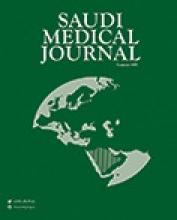Abstract
OBJECTIVE: To present our experience of carcinoid tumors of the appendix managed at a university teaching hospital. Complex symptomatology, varied biochemical affections and different surgical therapeutic modalities are discussed.
METHODS: The medical records of all the patients who underwent consecutive appendectomies at King Khalid University Hospital, Riyadh, Kingdom of Saudi Arabia from 1994 to 1999 were retrospectively analyzed. The data of patients identified to have histological evidence of carcinoid tumors of the appendix were further reviewed for the demographic details, indications for surgery, surgical procedure, tumor localization in the appendix and size; concomitant appendicitis and further surgical procedures were considered.
RESULTS: During the study period, 1547 appendectomies were performed and, out of these, 9 (0.6%) cases were reported to have carcinoid tumors of the appendix. There were 4 male and 5 female patients, age range 17-51 years (median 29.8 years). Seven subjects had a clinical evidence of appendicitis while 2 presented with chronic abdominal pain. There were 6 open and 3 laparoscopic appendectomies. Six carcinoid tumors were encountered at the appendiceal apex, 2 at the midportion, and one at the base with a mean diameter of 9.5 mm (range, 4-19 mm). One patient had histologically confirmed residual tumor, which necessitated a right hemicolectomy 3 weeks later. All patients remained disease-free during a mean follow up of 7 years (range, 4-10 years).
CONCLUSION: Carcinoid tumors of the appendix are extremely rare and invariably remain asymptomatic. Simple appendectomy offers adequate relief while the need for further extensive surgery depends on tumor characteristics and dissemination. Despite an excellent prognosis, all reported patients should be followed up with urinary 5-hydroxyindoleacetic acid and abdominal ultrasonography.
- Copyright: © Saudi Medical Journal
This is an open-access article distributed under the terms of the Creative Commons Attribution-Noncommercial-Share Alike 3.0 Unported, which permits unrestricted use, distribution, and reproduction in any medium, provided the original work is properly cited.






